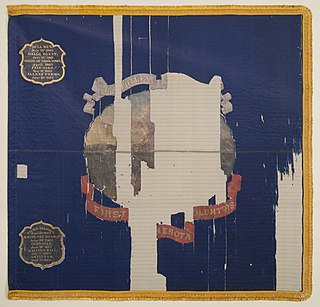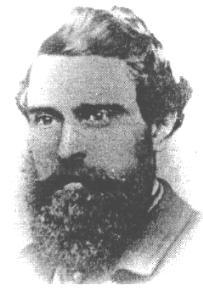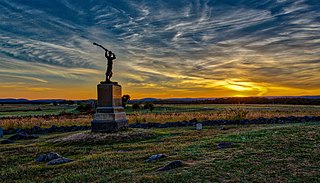The Irish Brigade was an infantry brigade, consisting predominantly of Irish Americans, who served in the Union Army in the American Civil War. The designation of the first regiment in the brigade, the 69th New York Infantry, or the "Fighting 69th," continued in later wars. The Irish Brigade was known in part for its famous war cry, the "Faugh a Ballaugh" which is an anglicization of the Irish phrase, fág an bealach, meaning "clear the way" and used in various Irish-majority military units founded due to the Irish diaspora. According to Fox's Regimental Losses, of all Union army brigades, only the 1st Vermont Brigade and Iron Brigade suffered more combat dead than the Irish Brigade during America's Civil War.

The 1st Minnesota Infantry Regiment was a Union infantry regiment active during the American Civil War. The 1st Minnesota participated in the battles of First Bull Run, Antietam and the Battle of Gettysburg. One of the regiment's most famous actions was on the second day of the Battle of Gettysburg when Major General Winfield Scott Hancock ordered the 1st Minnesota to charge into a brigade of 1,200 Confederate soldiers. This action blunted the Confederate attack and helped preserve the Union's precarious position on Cemetery Ridge.
The 8th Ohio Infantry Regiment was an infantry regiment in the Union Army during the American Civil War. It served in the Eastern Theater in a number of campaigns and battles, but perhaps is most noted for its actions in helping repulse Pickett's Charge during the Battle of Gettysburg.
The Philadelphia Brigade was a Union Army brigade that served in the American Civil War. It was raised primarily in the city of Philadelphia, Pennsylvania, with the exception of the 106th regiment which contained men from Lycoming and Bradford counties.

The 69th Pennsylvania Infantry was an infantry regiment in the Union army during the American Civil War.
The 106th Pennsylvania was a volunteer infantry regiment which served in the Union Army during the American Civil War. It was part of the famous Philadelphia Brigade, which helped defend against Pickett's Charge in the Battle of Gettysburg.

Patrick Kelly was an Irish-American Union Army officer during the American Civil War. He led the famed Irish Brigade at the Battle of Gettysburg.

The 72nd Pennsylvania Infantry was a volunteer infantry regiment which served in the Union Army during the American Civil War. It was part of the famous Philadelphia Brigade.

The 4th Pennsylvania Reserve Regiment, also known as the 33rd Pennsylvania Volunteer Infantry Regiment, was an infantry regiment that served in the Union Army during the American Civil War. It was a part of the famed Pennsylvania Reserves in the Army of the Potomac for much of the early part of the war and served in the Eastern Theater in several important battles, including Antietam and Fredericksburg.

The 118th Pennsylvania Regiment was a volunteer infantry regiment in the Union Army during the American Civil War. They participated in several major conflicts during the war including the Battle of Gettysburg, Siege of Petersburg, and escorted the truce flag of Robert E. Lee at the Battle of Five Forks. The regiment was led by Colonel Charles Prevost until he was seriously injured at the Battle of Shepherdstown in which Lieutenant-Colonel James Gwyn assumed command until the end of the war.

The 2nd Wisconsin Infantry Regiment was an infantry regiment that served in the Union Army during the American Civil War. It spent most of the war as a member of the famous Iron Brigade of the Army of the Potomac. It suffered the largest number of casualties as a percentage of its total enlistment of any Union Army unit in the war.
The 1st Delaware Infantry Regiment, later known as the 1st Delaware Veteran Infantry Regiment was a United States volunteer infantry regiment raised for Union Army service in the American Civil War. Part of the II Corps it served in the Eastern Theater of the American Civil War.

The Excelsior Brigade was a military unit in the Union Army during the American Civil War. Mainly composed of infantry regiments raised in the state of New York primarily by former U.S. Representative Daniel Sickles, the brigade served in several of the Army of the Potomac's most important battles in the Eastern Theater, including Chancellorsville and Gettysburg.
Henry J. Stainrook, occasionally spelled Steinrock, led a regiment of the Army of Virginia and the Army of the Potomac in the American Civil War. He briefly led a brigade at the Battle of Antietam. Stainrook was killed in the Battle of Chancellorsville.

The 151st Pennsylvania Infantry was a Union Army regiment serving for a term of nine months during the American Civil War. The regiment sustained seventy-six percent casualties in the Battle of Gettysburg, its only major engagement.
The Thirteenth Pennsylvania Reserve Regiment, also known as the 42nd Pennsylvania Volunteer Infantry, the 1st Pennsylvania Rifles, Kane's Rifles, or simply the "Bucktails," was a volunteer infantry regiment that served in the Union Army during the American Civil War. It was a part of the famed Pennsylvania Reserve division in the Army of the Potomac for much of the early and middle parts of the war, and served in the Eastern Theater in a number of important battles, including Antietam, Fredericksburg, and Gettysburg.

The 91st Pennsylvania Volunteer Infantry was a Union infantry regiment which fought in multiple key engagements of the American Civil War, including the Battle of Fredericksburg, Battle of Chancellorsville and Battle of Gettysburg. It was established through the combined efforts of Edgar M. Gregory, who had received approval from the U.S. War Department to begin recruiting soldiers for an entirely new regiment during the fall of 1861, and Edward E. Wallace, who had initiated his own recruitment efforts that October. Their recruits were volunteers, the majority of whom initially enlisted for three-year terms of service from their hometown of Philadelphia; they were divided into 10 lettered companies upon muster in during early December 1861: A, B, C, D, E, F, G, H, I, and K.
DeWitt Clinton Baxter (1829–1881) was an American artist and engraver. He also served as colonel and brevet brigadier general in the Union Army during the American Civil War.
The 2nd Delaware Infantry Regiment was an infantry regiment in the Union Army during the American Civil War.










